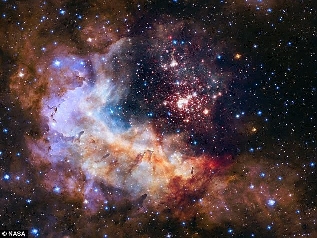 According to a new study, the universe we reside in could be abruptly destroyed in a cataclysmic collision with a bubble of ‘negative energy’ say, Harvard scientists, warning that this process may have even already begun without us even noticing.
According to a new study, the universe we reside in could be abruptly destroyed in a cataclysmic collision with a bubble of ‘negative energy’ say, Harvard scientists, warning that this process may have even already begun without us even noticing.Scientists explain how a fundamental particle that gives mass to all mater held within the universe could one day cause its destruction.
Astrophysicists warn that our universe may be abruptly destroyed, as it started in a bubble of negative energy, thought to have been created by the Higgins Boson, aka the God Particle. The famous Higgs boson particle, discovered in 2012 after more than fifty years of scientific persecution, has the power to end the existence of the Universe in which we live.
Not only that, but the process could have already started without us even noticing it.
In fact, there is a possibility that this partice has collapsed on itself in a far corner of the cosmos, producing an expanding vacuum energy bubble that would end up swallowing us all.
This authentic cosmic apocalypse is described in a recently published article in Physical Review.
The end of space and time is not a concept alien to Physics.
The Standard Model, in effect, the theory that describes all known forces and particles, predicts that, just as the Universe had a beginning, it will also have an ending.
As the dark energy continues to accelerate the expansion of the Universe, the matter in it will become increasingly dispersed and move further and further away, until the last star is extinguished and the entire cosmos is nothing more than an unfathomable, cold and black abyss bigger and scarier than ever, where nothing shines anymore.
The most accurate calculated estimate for the cosmic doomsday, based on the logical development of the four fundamental interactions of Nature, tells us that the end of the Universe will occur in around 10×139 years.
The new model of the “killer Higgs” developed by a team of researchers at Harvard University is much more unpredictable and dramatic.
In it, the Universe would end with a bang, and it would do so in a much shorter period of time.
“We wanted to correct all previous approaches and obtain a date as accurate as possible,” says Anders Andreassen, Harvard University and lead author of the study.
To achieve this, he and his colleagues used everything we know about the masses and interactions between particles, including the mass of the Higgs boson, the carrier of the force that confers its mass to all other particles, and which turned out to be 125 gigaelectronvolts.
And it is here, say researchers, in the mass of the Higgs boson, where the problem resides in.
The reason is that the mass recorded for the boson might not be the lowest possible for that particle, but simply a temporary value, which remains stable at present but could change one day.
The most careful calculations, in effect, suggest that our Universe could actually be a “false vacuum”, very different from the “true vacuum” that we would have in the lowest possible energy configuration.
To understand this concept, you can think of the Higgs as a ball that is trapped in the bottom of a shallow valley that represents its mass.
But on the other side of the hill, there is another much deeper valley that corresponds to a mass with less potential.
As the Higgs can not roll up the hill, it is “stuck” in its current configuration.
However, all subatomic particles, the Higgs boson among them, have the possibility of behaving like waves, and therefore do not have well-defined positions.
And there is always the possibility that the Higgs creates a “tunnel” through the hill and reaches the lower valley, which would result in a mass lower than what scientists have observed.
It would be precisely here where things would start to get really ugly, say experts.
In fact, due to the fact that the Higgs field provides mass to all other particles, a change in their properties would wreak havoc on the “building blocks” of our universe.
Chemistry, and therefore life, depends on these values, so that our current way of being would be completely nullified by this reorganization.
Since the universe we can observe from Earth is only a small portion of the total, the likelihood of extremely improbable things happening in places we cannot see increases considerably. And in such a large and hidden Universe, there exists the possibility of this “Higgs collapse” having happened in a place beyond our visibility, producing a bubble of negative energy that expands rapidly and in whose interior is a universe of crazed properties, according to our point of view.
This bubble can travel across the universe.
And one day, that bubble could reach us and also swallow our region of the cosmos.
According to Einstein’s theory of Relativity, information can not move faster than light, so it would be impossible for us to realize its arrival.
In the words of Andreassen “we would not even see it coming”.
As the physicist writes in his article, “it is very worrying to imagine this bubble, with its wall of negative energy, throwing itself at us at the speed of light”. For the researcher, instead of a slow stretch towards nothingness, our Universe could be on its way to an abrupt collision with one of these destructive bubbles.

 Home
Home
 Add article
Add article
 Horoscope
Horoscope
 Music
Music
 Photos
Photos Video
Video
 TV online
TV online
